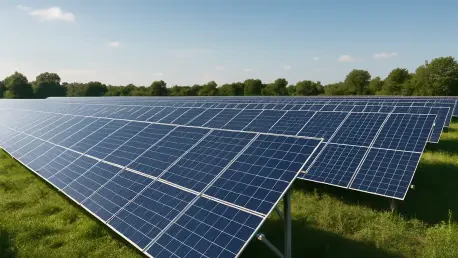In an era where renewable energy is pivotal to combating climate change, the global solar photovoltaic (PV) industry finds itself undergoing a dramatic transformation driven by policy interventions. Groundbreaking research published in Nature Communications this year sheds light on how tariffs, subsidies, and carbon pricing mechanisms are fundamentally altering the structure of solar PV supply chains across continents. These policies are not merely adjusting logistics but are redefining critical aspects of energy security, environmental sustainability, and international trade. As nations strive to balance domestic priorities with global decarbonization goals, the implications of these shifts are profound, touching on everything from cost structures to geopolitical stability. This exploration into the evolving landscape of solar PV production reveals both the opportunities for a cleaner energy future and the intricate challenges that must be navigated to achieve it.
The solar PV sector, essential for transitioning to a low-carbon economy, depends on complex supply networks that span raw material extraction to final module assembly. Historically, production has been heavily concentrated in certain regions, particularly East Asia, due to cost efficiencies and established industrial bases. However, emerging policies are disrupting this status quo by encouraging diversification and localization of manufacturing. Through sophisticated modeling, the research illustrates various scenarios where policy tools reshape supply chain dynamics, offering insights into potential impacts on emissions, innovation, and economic viability. This transformation is as much about mitigating risks as it is about seizing new opportunities in the renewable energy space.
Navigating New Manufacturing Horizons
Driving Forces Behind Localization
The push for localization in solar PV manufacturing is gaining momentum as national policies like tariffs and subsidies aim to reduce dependency on dominant foreign suppliers. Many countries are now prioritizing the relocation of production closer to demand centers, a strategy often termed onshoring or re-localization. This shift is largely motivated by the need to enhance energy security, especially in light of geopolitical uncertainties that have exposed vulnerabilities in over-concentrated supply chains. By fostering domestic industries, governments hope to insulate themselves from external disruptions while also creating jobs and stimulating local economies. However, this transition is not without hurdles, as it demands substantial policy coordination to ensure that localized production remains competitive on a global scale. The research highlights that while the intent behind such measures is clear, the execution often reveals gaps in readiness that could undermine long-term goals.
Building local capacity for solar PV manufacturing requires more than just financial incentives; it necessitates robust infrastructure and a skilled workforce capable of meeting industry standards. Many regions embarking on this journey face significant challenges, from establishing reliable energy grids for production to training personnel in advanced manufacturing techniques. The upfront costs of such endeavors can be daunting, particularly for economies with limited resources or industrial experience in this sector. Furthermore, integrating these new hubs into existing global trade networks poses additional complexities, as misaligned regulations or standards can create inefficiencies. The study underscores that without strategic planning and sustained investment, the dream of self-reliant solar industries risks becoming a costly misstep rather than a stepping stone to energy independence.
Challenges of Scaling Domestic Production
Scaling up domestic production of solar PV components is a multifaceted challenge that goes beyond mere policy enactment. One pressing issue is the availability of critical raw materials, such as high-purity silicon and rare metals, which are often sourced from specific global regions. As manufacturing shifts to new locales, ensuring a stable supply of these inputs becomes paramount, yet it introduces risks of bottlenecks or price volatility. Additionally, the environmental impact of setting up new facilities must be considered, as rushed development could lead to unsustainable practices that contradict the very goals of renewable energy. Policymakers are thus tasked with crafting frameworks that address these supply and ecological concerns while fostering industrial growth, a balancing act that requires foresight and adaptability.
Another layer of complexity lies in aligning domestic production with global market dynamics. While subsidies can jumpstart local industries, they often inflate costs if not carefully calibrated, potentially rendering products less competitive against established players. This economic trade-off is a recurring theme in the research, which suggests that without harmonized trade policies, countries risk isolating themselves from the benefits of international collaboration. Moreover, the transition to localized manufacturing can strain existing trade relationships, sparking disputes or retaliatory measures that hinder the broader energy transition. Addressing these economic and diplomatic challenges is crucial to ensure that the shift toward domestic production contributes positively to both national interests and global sustainability objectives.
Environmental and Geopolitical Realignments
Harnessing Policies for Greener Production
Environmental considerations are at the forefront of policy interventions reshaping solar PV supply chains, with tools like carbon pricing and border adjustments gaining traction as mechanisms to promote cleaner production. These measures incentivize manufacturers to adopt low-carbon energy sources and sustainable sourcing practices, tackling the significant emissions associated with upstream processes such as mining and transportation. The research indicates that by aligning industrial strategies with climate goals, there is a tangible opportunity to reduce the lifecycle carbon footprint of solar modules. This alignment, however, requires meticulous policy design to ensure that environmental benefits are not offset by unintended economic burdens or operational inefficiencies. The potential to transform solar PV into a truly green technology hinges on the ability to integrate these environmental mandates seamlessly into production frameworks.
Beyond reducing emissions, environmental policies also encourage a rethinking of supply chain logistics to minimize ecological impact. Localized production, for instance, can cut down on long-distance shipping, a major contributor to carbon output in the industry. Yet, this shift must be supported by access to clean energy grids in new manufacturing hubs to avoid replacing one form of pollution with another. The study emphasizes that while the environmental promise of such policies is significant, their success depends on international cooperation to standardize practices and prevent loopholes that could undermine progress. Without a cohesive global approach, disparities in policy enforcement could lead to uneven benefits, where some regions advance in sustainability while others lag, perpetuating environmental inequities.
Balancing Trade Dynamics and Resource Access
Geopolitical risks are an inherent part of the supply chain transformation, particularly as manufacturing relocates to diverse regions with varying levels of stability and resource availability. Access to critical materials like rare metals, often concentrated in specific areas, becomes a flashpoint for potential conflict or scarcity as demand grows. The research warns that without proactive measures to secure supply lines, countries could face disruptions that slow solar PV deployment. Additionally, unilateral policies aimed at protecting domestic industries risk escalating into trade disputes, creating friction that could derail collaborative efforts toward decarbonization. The call for multilateral agreements is strong, as they offer a pathway to balance national security concerns with the collective need for a stable, sustainable energy future.
The economic ramifications of geopolitical shifts in solar PV supply chains are equally noteworthy. As countries vie for control over key resources or manufacturing dominance, the cost of solar technology could fluctuate, impacting affordability and accessibility worldwide. The study suggests that fostering transparent trade frameworks is essential to mitigate such risks, ensuring that competition does not come at the expense of global progress. Moreover, addressing resource access challenges requires innovative approaches, such as investing in recycling technologies to recover materials from end-of-life solar panels. By anticipating these geopolitical and economic undercurrents, policymakers can craft strategies that safeguard both national interests and the shared goal of a renewable energy-driven world.
Innovation and Ethical Frontiers
Accelerating Technological Breakthroughs
Policy-driven changes in solar PV supply chains are acting as catalysts for technological innovation, spurring investments in cutting-edge manufacturing processes that promise to redefine the industry. Advances in high-purity silicon processing and automated assembly lines are among the developments gaining traction, driven by the need to enhance efficiency and reduce production costs. These innovations not only improve the performance and durability of solar modules but also contribute to lowering the levelized cost of energy, making solar power more accessible across diverse markets. The research highlights that as countries compete to establish robust domestic industries, the race for technological supremacy is accelerating, offering a glimpse into a future where solar energy could become even more competitive with traditional power sources.
However, the benefits of technological progress are not guaranteed and depend heavily on supportive policy environments. Without clear regulations and funding for research and development, emerging innovations risk stalling or being unevenly adopted, widening disparities between regions. The study points out that while some nations are poised to lead in areas like next-generation solar cell designs, others may struggle to keep pace due to financial or infrastructural constraints. Ensuring that technological advancements are shared or adapted globally is crucial to prevent a fragmented energy landscape. This underscores the importance of international partnerships in technology transfer, which can help democratize access to innovations and amplify their impact on the global energy transition.
Prioritizing Equity in Transition
As solar PV supply chains diversify under policy pressures, ethical considerations around labor practices and community impacts come into sharp focus. New manufacturing hubs, often established in regions with lower operational costs, must avoid replicating past mistakes of exploitation or environmental neglect. The research emphasizes that policies should mandate fair labor standards and ensure that local communities benefit from industrial growth through job creation and infrastructure development. This ethical dimension is not just a moral imperative but a practical one, as social unrest or backlash can derail projects and tarnish the reputation of the renewable energy sector. Crafting inclusive policies that prioritize equity alongside economic and environmental goals is essential for a just transition.
Moreover, addressing equity in the energy transition extends to ensuring that the benefits of solar technology reach underserved regions and populations. Disparities in access to affordable renewable energy solutions can exacerbate existing inequalities, undermining the broader mission of sustainability. The study advocates for targeted initiatives that support small-scale solar projects or community-driven energy programs in vulnerable areas. By embedding social justice into supply chain policies, governments and industry leaders can build trust and foster long-term support for renewable energy adoption. This holistic approach, balancing ethical imperatives with practical outcomes, is vital to ensure that the transformation of solar PV supply chains contributes to a fairer, more sustainable global energy landscape.
Reflecting on a Path Forward
Looking back, the transformative journey of global solar PV supply chains under policy influence reveals a landscape of both promise and complexity. The intricate dance between national strategies and international cooperation underscores the delicate balance required to advance decarbonization without sacrificing efficiency or equity. Insights from the research provide a roadmap, showing how tools like carbon pricing and subsidies reshape manufacturing geographies while highlighting vulnerabilities that demand attention. The push for innovation and cleaner production stands out as a beacon of progress, even as geopolitical tensions and economic trade-offs pose persistent challenges.
Moving forward, the focus must shift to actionable strategies that build on these lessons. Policymakers should prioritize multilateral frameworks to harmonize trade and environmental standards, preventing fragmentation that could slow renewable energy growth. Investing in resilient supply networks and ethical practices will be key to mitigating risks and ensuring that the benefits of solar technology are equitably shared. Additionally, sustained support for technological research can unlock further efficiencies, driving down costs and broadening access. As the energy transition accelerates, these steps offer a foundation to navigate future uncertainties, ensuring that solar PV remains a cornerstone of a sustainable world.









